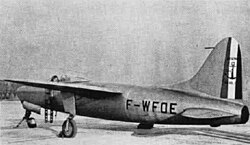Arsenal VG-90
| Arsenal VG-90 | |
|---|---|

|
|
| Type: | Carrier fighter |
| Design country: | |
| Manufacturer: |
Arsenal de l'Aéronautique |
| First flight: |
September 27, 1949 |
| Number of pieces: |
2 |
The Arsenal VG-90 was a jet - powered, carrier-based fighter aircraft produced by the French manufacturer Arsenal de l'Aéronautique .
history
On June 3, 1946, the French Navy issued a specification for a carrier-based fighter that was supposed to reach a top speed of 900 km / h. In addition to the VG-90 developed by Vernisse and Galtier, the Aérocentre NC 1080 and Nord 2200 designs were also submitted. The VG-90 was based on experience with the Arsenal VG-70 and took off on September 27, 1949 in Villaroche with Modeste Vonner on board for its 15-minute maiden flight. On January 26, 1950, the aircraft reached a speed of 800 km / h, and on April 1, the comparative flight with the other designs began in the flight test center Center d'Essais en Vol. On May 25, 1950, the pilot, who was actually intended as a test pilot, but At the start of the test, Pierre Decroo violated a test flight with the machine. As a conclusion, he started a low-altitude approach to Brétigny , when part of the landing gear flap probably came loose, hit the horizontal stabilizer and Decroo lost control of the machine, fell and was killed in the process. The accident delayed the flight test program by almost a year, so that the second only slightly improved prototype did not take off for its first flight until June 1951. On February 21, 1952, this prototype also crashed at Gipcy during a flight to Istres due to a design fault in the servo control - which caused the aircraft to flutter and the tailplane then tore off . The pilot Claude Dellis was killed, as well as the built- Martin-Baker - ejection seat failed. As a result, the project was discontinued in June 1952 in favor of the Sud-Est Aquilon and the construction of the third prototype, which was the first machine of the series version VG-91 to be equipped with a SNECMA Atar 101F engine, was canceled. This was scrapped in July 1978.
construction
The VG-90 was a single-engine, single - seat low - wing aircraft with a conventional tail unit in all-metal construction, with the first prototype still having a structure made of metal beams with birch wood planking . The air inlets for the Hispano-Suiza - Nene engine (a production license from Rolls-Royce ) were located on the side of the fuselage under the wing swept by 25 °.
Technical specifications
| Parameter | Data |
|---|---|
| crew | 1 |
| length | 13.44 m |
| span | 12.6 m |
| height | 3.55 m |
| Wing area | 30.7 m² |
| Empty mass | 5555-5725 kg |
| Max. Takeoff mass | 8200-8719 kg |
| Top speed | 855 km / h near the ground |
| Service ceiling | 12,000 m |
| Climb performance | 15 m / s |
| Engine | a Hispano-Suiza (Rolls-Royce) Nene with 22.2 kN thrust |
| Armament | three 30 mm HS 602 cannons from Hispano-Suiza were planned |